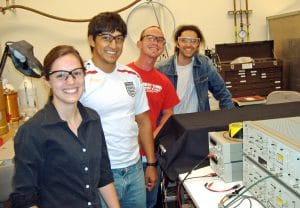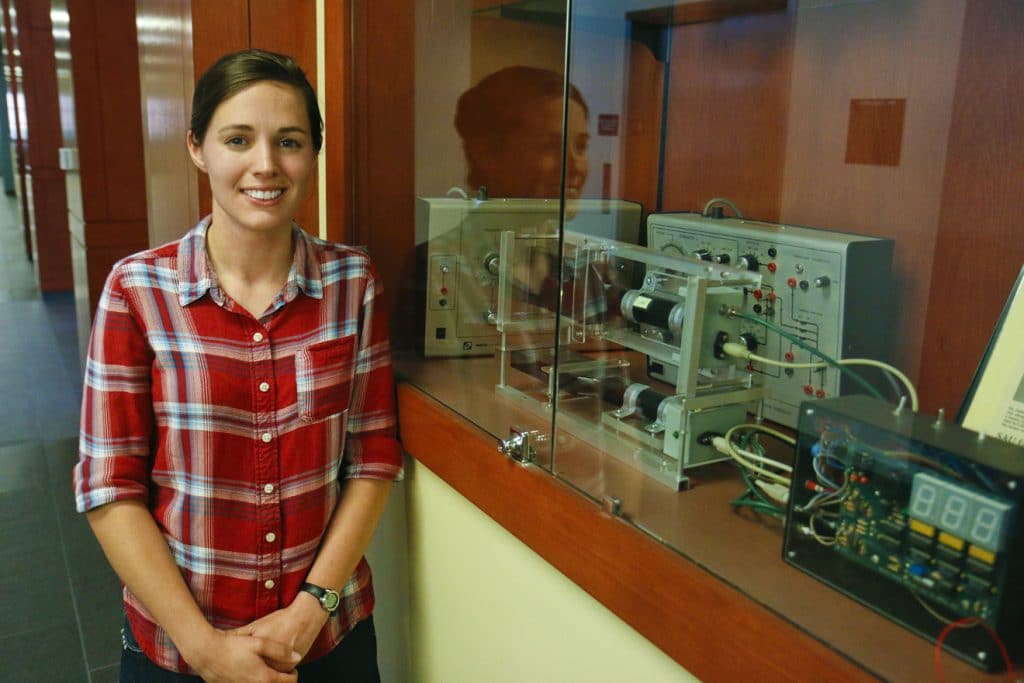Following up a four-year Engineering-Physics degree with a grueling six-year Biophysics doctorate program would be challenging for the most resilient researcher. For Amanda Taylor of Emerson, Arkansas, it was just another leg of her journey toward becoming a university professor.
Her next phase is a post-doctoral research opportunity at the Baylor College of Medicine in Houston, which began June 1, 2016.
On a pre-move visit with her undergraduate family at Southern Arkansas University, she expressed relief in completing her Ph.D.
“The whole Ph.D. was stressful, and it took a span of six years. If I would have stopped at any point before finishing it would have been a waste. There were many times I wanted to quit, especially towards the end,” she said.
It was her church family in Stillwater, and a community service program she was a part of initiating, that got her through the hard times.
“My only strength was the church and the people of the church I attended while at OSU – Abundant Life United Pentecostal. I got to reach out and help others in their need, instead of dwelling on my own issues and discouragements. If I helped others, I was able to see that life is beyond my petty problems.”
Around three years into her Ph.D. research, she and a group of about 20 church members, mainly college-age “kids,” organized an outreach program they called Compassion in Action. She said they worked at the area youth shelter, where they mowed the grass weekly and played with the kids. They prepared and delivered food to those in need and to service men and women.
“We alternated; some of us would do the mowing or tree cutting and another group would feed the firefighters a meal of chili and cake,” she said as a for-instance. “The firefighters loved it, and we are able to bring kids to see the firefighters. It was a warm welcome.”
Another time the Compassion in Action group “got to” clean out a home that was completely infested with roaches. Taylor said the family living there was poverty-stricken and in dire need of the group’s help.
After a hard-day’s work in the community, the next best way to relieve stress was to sometimes play football, said the petit Taylor with a smile. “I had the nickname Speedy. I think we had more injuries with two-hand touch than they do in tackle.”
Risk-taking she learned from what she still considers the best advice she’s ever gotten. Interestingly, this life lesson came in a mathematics class courtesy of Dr. Hasan Shehada at SAU.
“I loved him. He would be teaching and ask us a question. We would be squirming in our seats,” she admitted. “He would try to get us to at least guess. ‘Are you afraid to make a mistake? Have you ever made a mistake in your lives? Do you think you’ll ever make a mistake again?’”
“I loved him. He would be teaching and ask us a question. We would be squirming in our seats,” she admitted. “He would try to get us to at least guess. ‘Are you afraid to make a mistake? Have you ever made a mistake in your lives? Do you think you’ll ever make a mistake again?’”
She said that line of questioning is how he would prod the students to “go for it” and make mistakes.
“It’s risk taking. It’s how you learn. Make mistakes and make them often. It’s how you learn to write computer programs; it’s how you learn to ride a bike,” she said with a wisdom and fearlessness seemingly beyond her years.
During her time at SAU, she also received career-focused motivation. She remembers projects relating to electricity from eels and other bio-electric phenomena. In Advanced Physics Lab, she used two Helmholtz coils and a cathode ray tube to create a shining beam of electrons and measure the charge-to-mass ratio of an electron.
“It was a fundamental experiment, but it was enlightening to me,” she quipped with a humor so dry it could easy go undetected.

She credits Bachri with not only spurring her interest in research, but also modestly for helping her get accepted into Oklahoma State University’s program. “He is an OSU alum, and he put a good word in for me.”
Her Ph.D. research at OSU continued on her interest in biophysics. She utilized NMR (Nuclear Magnetic Resonance) spectroscopy as a chemical analysis tool to discover phases of mineral in bone, how new bone forms, how it aggregates, etc. The findings were intended to make diagnostic predictions for patients suffering from bone loss, such as those with osteoporosis or in diabetic patients in which bone loss are not yet well explained.
For her post-doc research, she will be looking at the brain’s response to different visual stimuli using MRI technology to measure changes in blood flow, she explained in the simplest terms possible. The end goal is to map which stimuli activate different areas of the brain once they find a model of blood flow using fluid dynamics.
Taylor is a 2005 graduate of Emerson High School and a 2009 graduate of SAU. She completed her Ph.D. in July 2015. She has since had the opportunity to teach college courses, a talent and interest she discovered as a teaching assistant at OSU.
“I found out I really enjoyed teaching. After a few semesters as a Physics II teaching assistant, I was trusted with my own course – Descriptive Physics. It was a non-science majors course, and it was a blast to teach.”
A passion she is willing to invest more than 10 years of higher education, her teaching and learning influences go well back to both her parents and the small school at Emerson.
“My mother was academic-minded and my dad was engineering-minded. He was one that people would call a genius because he can work on and build anything, like the house I grew up in.”
The seed for medical interest was planted by her mother, who is a nurse. Her hands-on curiosity clearly comes from her father.
She recalled a fifth-grade summer program at SAU Tech in Camden that really ignited her interest in engineering. “We learned all about the dynamics of airplanes and how they work. It was awesome!”
Fast-food or retail was not in the cards for Taylor’s teen years after-school job; she got her hands dirty at machine shops while in high school and well into college. Her senior year at SAU she produced CAD drawings for a local industrial service provider.
On campus she enjoyed being a part of the Honors College and living in Honors Hall. She earned a choral scholarship, and also held a campus work-study job. She graduated with honors.

